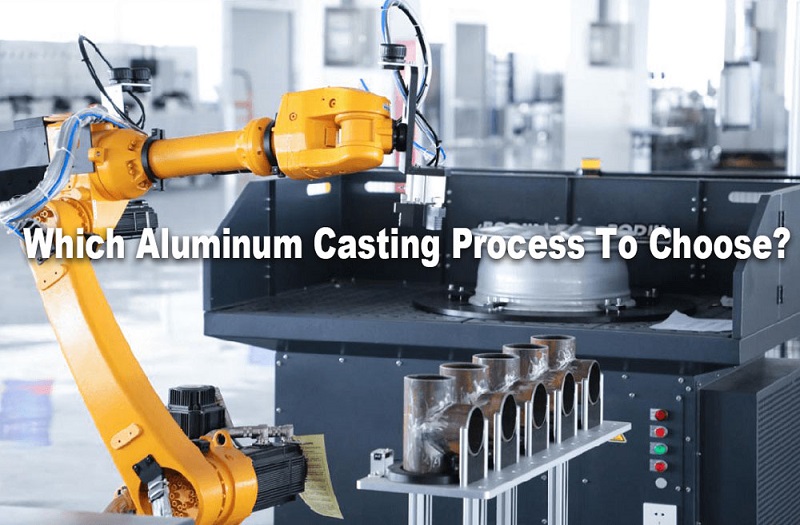Which Aluminum Casting Process Should You Use - Die Casting, Sand, Permanent Mold, Investment?
For any type of metal including the aluminum, casting is the most versatile of all of the forming processes, and results in the greatest variety of parts. There are four basic types of aluminum casting methods, sand casting method, investment casting method, die casting method and the permanent mold casting method. In this article, we tell the differences between the available aluminum casting methods with showing the benefits of each type of aluminum casting, so you can better determine which aluminum casting methods is right for you.

4 Common Aluminum Casting Process – What’ The Difference Between Them
There are several further choices to consider when deciding how to cast aluminum parts for your application. Here we list 4 common types of aluminum casting methods and you can find out the difference between die casting, sand casting, permanent mold casting and investment casting.
1. Die Casting
The die casting process forces molten aluminum into a steel die (mold) under pressure. This manufacturing technique is usually for high-volume products. So if you’re not a motive guy and you’re using hundreds of thousands of parts, you got to go die casting. If you’re making a whole bunch of knobs for your kitchen sink, die casting is the right choice.
Typical applications of die cast aluminum alloys include:
– Alloy 380.0 – Lawnmower housings, gear
– Alloy A380.0 – Streetlamps housings, typewriter frames, dental equipment
– Alloy 360.0 – Frying skillets, cover plates, instrument cases, parts requiring corrosion resistance.
– Alloy 413.0 – Outboard motor parts such as pistons, connecting rods, and housings
– Alloy 518.1 – Escalator parts, conveyor components, aircraft and marine hardware and lit tings.
Advantages of aluminum die casting process:
– Parts can be cast with greater detail and superior surface finish
– Dies, often machined from high-grade tool steel, last longer than other molds
2. Permanent Mold Casting
Permanent mold casting involves molds and cores of steel or other metal. Molten aluminum is usually poured into the mold, although a vacuum is sometimes applied. Like die casting, permanent mold casting is suited to high-volume production, usually is about 10 kg. Permanent mold castings are gravity-fed and pouring rate is relatively low, but the metal mold produces rapid solidification. Permanent die casting is closer to the die casting surface finish but you’re getting a lot closer to a sand casting cost.
Some common aluminum permanent mold casting alloys, and typical products cast from them, are presented below.
– Alloy 366.0 – Automotive pistons
– Alloys 355.0, C355.0, A357.0 – Timing gears, impellers, compressors, and aircraft and missile components requiring high strength
– Alloys 356.0, A356.0 – Machine tool parts, aircraft wheels, pump parts, marine hardware, valve bodies
– Other aluminum alloys commonly used for permanent mold castings include 296.0, 319.0, and 333.0.
Advantages of permanent mold casting:
– Exhibits excellent mechanical properties. Castings are generally sound, provided that the alloys used exhibit good fluidity and resistance to hot tearing.
– Repeatability is high, and little preparation needs to be made between castings.
– High dimensional accuracy can be achieved if an accurately machined mold is used.
3. Sand Casting
In this method, a mold is created from a sand mixture, containing a cavity into which the molten aluminum alloy from which your part will be created is poured. Once the aluminum cools and solidifies, the sand mold is broken away from the part.Sand castings are used when you want cheap tooling and you don’t need a lot of good quality surface finish and tolerances are more wide open. Sand castings will give variation from part to part, you can definitely have gassing issues in sand casting.
4. Investment Casting
Investment casting cannot cast any alloy, that’s their sweet spot. So you can cast inconel, you can connect cast stainless steel, you can cast aluminum, you can cast iron. The problem with investment casting is a very expensive process they make and break the shell every single casting. So your piece price is going to be significantly higher.
Aluminum alloys commonly used for investment castings are: 208.0, 295.0, 308.0, 355.0, 356.0, 443,0, 514.0, 535.0 and 712.0.
How Do You Choose The Aluminum Casting Method?
Surface finish: Permanent mold is good for moderate volume nice size castings. When you want precision and when you want a good surface finish and you’re trying to get the most benefit from the alloy, permanent mold casting and die casting methods are the most suited.
Cost: Tooling costs for all four processes, the cheapest is going to be sand casting. Investment castings are not that expensive tooling wise, die castings are the very most expensive, very automated cooling long lead times.
Strength: Permanent mold casting provides the greatest material strength in the finished product. Although similar to die casting, the pieces produced via permanent mold casting have an advantage in this area due to the nature of the process.
Prototypes and short runs: Sand casting is the method of choice when only a few pieces are needed, thanks to its low tooling cost.

